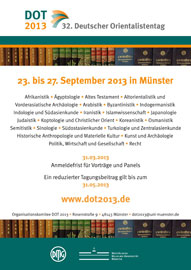“Syria’s cultural heritage is under threat”
Researchers expect the destruction of evidence of one of mankind’s oldest cultures – 32nd German Oriental Studies Conference investigates the history of the ancient Orient

Plaster cast of the law collection of Hammurapi
Scholars are warning of the destruction and looting of cultural goods, thousands of years old, as a result of the civil war in Syria. “Countless people have died because of the battles, and their culture, which is 5,000 years old and includes the earliest texts of mankind, has also been lost”, says Ancient Near Eastern Studies Scholar Prof. Dr. Hans Neumann from the committee of the 32nd German Oriental Studies Conference (Deutscher Orientalistentag, DOT) which over 1,000 Oriental researchers from all over the world are expected to attend in September at the University of Münster. The discipline of Ancient Near Eastern Studies reckons with irrecoverable losses in Syria. “Many Syrians are also suffering from the destructions and illicit excavations. They are proud of historical World Heritage Sites such as Aleppo, Damascus and Palmyra, and also base their identity on ancient Near Eastern history.”
UNESCO recently put Syrian sites on the list of World Heritage in danger. There is currently no reliable information on the state of the sites. “As in Iraq and Afghanistan, we are certainly dealing with massive war damage to historical buildings, archaeological excavation sites and museums”, according to Prof. Neumann, “even though, on account of the war, little is known yet about the precise degree.”
Smugglers take historical evidence such as cuneiform texts, seals, metal items or pottery abroad. These artefacts come from ancient palaces, temples or private residences and are then sold on the black market, explains the expert for Sumerian and Akkadian cuneiform texts, referring to the experiences since the Iraq War. “Even if the items are confiscated, what we researchers miss is the overall context: in which settlement, in which house and in which room were the items found? The finds’ complex historical and social context cannot be reconstructed this way.”

Prof. Dr. Hans Neumann
Invention of the wheel
According to the expert, in order to be able to assess the scope of the losses, it must be taken into consideration that the high culture of the Ancient Near East began as early as the 4th millennium B.C. with the oldest texts of mankind written in cuneiform in Mesopotamia, today’s Iraq. While there was no such cultural evidence in Europe at that time, the first states were already developing in the ancient Near Eastern cultures of the Sumerians, the Babylonians and the Assyrians. “We are in debt to the ancient Near East for achievements such as the writing, the wheel, the bronze metallurgy, monumental architecture, and the oldest laws – including the famous laws of Hammurapi.” The loss of the archaeological legacy and written records due to wars in Syria, Iraq and Afghanistan are all the more dramatic. In crisis regions such as these, science needs the support of European institutions like that of the German Archaeological Institute (Deutsches Archäologisches Institut, AI), which trains Iraqi researchers in how to secure objects.
Guest of honour: Jean-Jacques Glassner
At the 32nd German Oriental Studies Conference (Deutscher Orientalistentag, DOT), taking place from 23 to 27 September in Münster, national and international representatives of Ancient Near Eastern Studies and Archaeology present in their sections the latest research on the “Social history of the ancient Near East”. The renowned assyriologist Prof. Dr. Jean-Jacques Glassner from Paris will be the guest of honour, speaking about the understanding of history of scholars in Mesopotamia. Together with the University of Münster’s professor of Ancient Near Eastern Archaeology, Reinhard Dittmann, Prof. Neumann will head the section in which researchers from Germany, France, Austria, Iraq and the USA are expected.
In Ancient Near Eastern Studies, the languages, history and cultures of the ancient Near East are investigated from the emergence of the first cuneiform texts in the late 4th millennium B.C. until the extinction of this type of writing around the turn of the eras. Its most important sources are the many thousand texts written in cuneiform on clay tablets which have survived the millennia. The texts primarily originate from the regions of present-day Iraq, Syria, Iran and Turkey, and to a lesser extent also from the Levant and even from Egypt.

Poster of the 32nd German Oriental Studies Conference
On the DOT committee, Prof. Neumann represents the classical and ancient studies in the field of Oriental studies. He is the former president of the German Oriental Society (Deutsche Orient-Gesellschaft, DOG) and has been professor in Münster since 1999 and member of the board of directors of the Centrum für Geschichte und Kultur des östlichen Mittelmeerraums (Centre of the History and Culture of the Eastern Mediterranean Region) at the University of Münster since 2010. Prof. Neumann is editor of the renowned “Orientalistische Literaturzeitung” (Oriental literary journal) and author of “Keilschriftbibliographie” (cuneiform bibliography) published annually in Rome. His research focus includes the editing of Sumerian and Akkadian cuneiform texts from the Berlin Museum of the Ancient Near East as well as from smaller national and international collections. Furthermore, he works on cuneiform texts from the DOG’s Assur excavations and from the DAI’s Uruk excavation, and focuses on the history of law and the economic and social history of the ancient Near East. (vvm)

